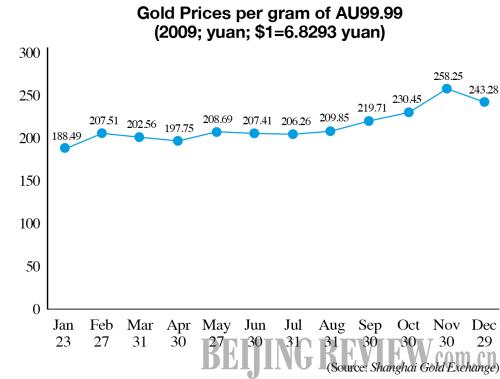| 
Numbers of the Week
5,000 yuan
Per capita net income of Chinese farmers was expected to top 5,000 yuan ($732.2) in 2009, an increase of more than 6 percent, according to the Central Rural Work Conference held on December 27-28, 2009.
288.94 million
China's output of raw coal in November 2009 was 288.94 million tons, an increase of 26.3 percent year on year, according to the National Bureau of Statistics.
TO THE POINT: China's consumption sector makes year-on-year gains, but more efforts are needed to polish its long-term prospects. China is on track to replace Germany as the world's biggest exporter, though clouds gather over recovery efforts in the trade sector. International venture capital sets its eyes on Chinese video websites, which aim to turn losses into profits. Telecom equipment provider Huawei leaps past foreign competitors on the back of technological advances. Industrial enterprises bask in the glow of economic recovery as they begin to rake in juicy profits once again.
By HU YUE
Consumer Efforts
If it is true China has fully shaken off the economic downturn, consumption deserves much of the credit.
Retail sales for consumer goods in November 2009 increased 15.8 percent from a year earlier, a sign that consumers are stepping up to fill in the gap left by plummeting exports.
Nevertheless, long-term prospects for the sector may be less promising. Government and enterprise purchases contribute 66 percent of the increases in retail sales, while households accounted for the remaining 34 percent, said the Chinese Academy of Social Sciences in a December report. The findings are evidence that households are still unwilling to relax their austerity.
For decades, thrift has entrenched itself as a common value as Chinese residents save for the future. The recent economic recovery and stock market gains might make savings somewhat less urgent, but will not simply eliminate the desire to save altogether.
Since repairing the social safety net will be a protracted effort, the job of spurring consumption has been placed mostly in the hands of powerful policy stimulus measures, which have sparked a housing and automobile buying rush.
But after purchasing a car or home, consumers are likely to become even more hesitant toward daily consumption as they may have mortgages and other bills to pay, said Huang Yasheng, an economics professor at the Massachusetts Institute of Technology, in an interview with the Beijing-based Global Entrepreneur magazine.
"It is imperative for policymakers to replace the temporary stimulus with more permanent incentives, such as wage growth and reforms to the healthcare and pension systems," Huang said.
Export Champion
In the final months of 2009, China was set to overtake Germany as the world's top exporter, a reflection of the competitive edge of Chinese goods, said Zhong Shan, Vice Minister of Commerce, in a statement on December 27, 2009.
After taking a hit from the financial meltdown, China's exports were caught in a tight spot, though government stimulus provided some respite. Exports in the first 11 months of 2009 fell 18.8 percent year on year, according to data from the Ministry of Commerce.
But export woes of other countries were even more severe, paving the way for China to win a larger piece of the shrinking global trade pie. Zhong expected China to account for 9 percent of all global exports in 2009, an increase from 8 percent in 2008.
A recent State Information Center report forecasts a rise in exports of about 6 percent in 2010, marking a turnaround from the slump in 2009.
Waving aside the optimism, however, Zhong said it is still too early to predict prospects for 2010 as trade protectionism still looms as a potential threat to the export market.
By November 3, 2009, China had suffered 101 trade remedy investigations from 19 countries and regions involving nearly $11.7 billion in exports.
Domestic exporters now must upgrade their technologies and products in order to move up in the value chain, Zhong said.
| 